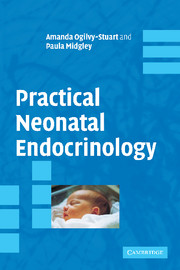Book contents
- Frontmatter
- Contents
- Acknowledgements
- Introduction
- 1 Hyperglycaemia
- 2 Hypoglycaemia
- 3 Management of hyperinsulinism
- 4 Hypoglycaemia in infant of a diabetic mother
- 5 Dysmorphic features
- 6 Micropenis
- 7 Hypopituitarism
- 8 Ambiguous genitalia (male): XY disorders of sex development
- 9 Cryptorchidism
- 10 Ambiguous genitalia (female): XX disorders of sex development
- 11 Pigmented scrotum
- 12 Adrenal failure
- 13 Collapse
- 14 Hypotension
- 15 Hyponatraemia
- 16 Hyperkalaemia
- 17 Hypernatraemia
- 18 Maternal steroid excess
- 19 Hypercalcaemia
- 20 Hypocalcaemia
- 21 Investigation and management of babies of mothers with thyroid disease
- 22 Maternal or familial thyroid disease
- 23 Goitre
- 24 Abnormal neonatal thyroid function tests
- 25 Hypothyroxinaemia in preterm infants
- Appendix 1 Calculation of glucose infusion rate
- Appendix 2 Dynamic tests
- Appendix 3 Normal ranges
- Appendix 4 Biochemistry samples
- Appendix 5 Formulary
- Index
13 - Collapse
Published online by Cambridge University Press: 15 February 2010
- Frontmatter
- Contents
- Acknowledgements
- Introduction
- 1 Hyperglycaemia
- 2 Hypoglycaemia
- 3 Management of hyperinsulinism
- 4 Hypoglycaemia in infant of a diabetic mother
- 5 Dysmorphic features
- 6 Micropenis
- 7 Hypopituitarism
- 8 Ambiguous genitalia (male): XY disorders of sex development
- 9 Cryptorchidism
- 10 Ambiguous genitalia (female): XX disorders of sex development
- 11 Pigmented scrotum
- 12 Adrenal failure
- 13 Collapse
- 14 Hypotension
- 15 Hyponatraemia
- 16 Hyperkalaemia
- 17 Hypernatraemia
- 18 Maternal steroid excess
- 19 Hypercalcaemia
- 20 Hypocalcaemia
- 21 Investigation and management of babies of mothers with thyroid disease
- 22 Maternal or familial thyroid disease
- 23 Goitre
- 24 Abnormal neonatal thyroid function tests
- 25 Hypothyroxinaemia in preterm infants
- Appendix 1 Calculation of glucose infusion rate
- Appendix 2 Dynamic tests
- Appendix 3 Normal ranges
- Appendix 4 Biochemistry samples
- Appendix 5 Formulary
- Index
Summary
Clinical presentation
Collapse.
Pointers to an endocrine cause
Dysmorphic facies and micropenis or ambiguous genitalia (suggesting hypopituitarism, especially if associated with hypotension, see Chapter 7).
Pigmented scrotum (see Chapter 11).
Hypoglycaemia (see Chapter 2).
Low plasma sodium and raised potassium suggesting an adrenal cause (see Chapters 12, 15, and 16).
Hypernatraemia (suggesting diabetes insipidus, see Chapter 17).
History of birth asphyxia.
Parental consanguinity or history of neonatal death.
Approach to the problem
The differential diagnosis depends on the age (and gestation) of the infant.
Rapid assessment of circulatory status (heart rate, blood pressure (BP), pulses, and perfusion) and resuscitation as appropriate.
Differential diagnosis
Acute problem with ventilation (including aspiration).
Sepsis.
Acute blood loss (placenta, arterial line, intraventricular haemorrhage, and gut).
Necrotizing enterocolitis.
Duct-dependent cardiac lesion, e.g. hypoplastic left heart (assess peripheral pulses).
Metabolic (inborn error of metabolism).
Addisonian crisis (structural or functional absence of pituitary or adrenal glands, e.g. pituitary infarction, toxoplasmosis, adrenal hypoplasia congenita, adrenocorticotrophic hormone (ACTH) resistance, and stressed infant with congenital adrenal hyperplasia).
Salt losing crisis in congenital adrenal hyperplasia.
Examination should be performed for signs of respiratory, cardiovascular, or gut abnormality, and investigations undertaken to exclude non-endocrine causes.
Investigations for possible endocrine causes
Blood gas for acid–base status.
Blood glucose and hypoglycaemia screen if indicated (see Chapter 2).
[…]
- Type
- Chapter
- Information
- Practical Neonatal Endocrinology , pp. 93 - 94Publisher: Cambridge University PressPrint publication year: 2006



